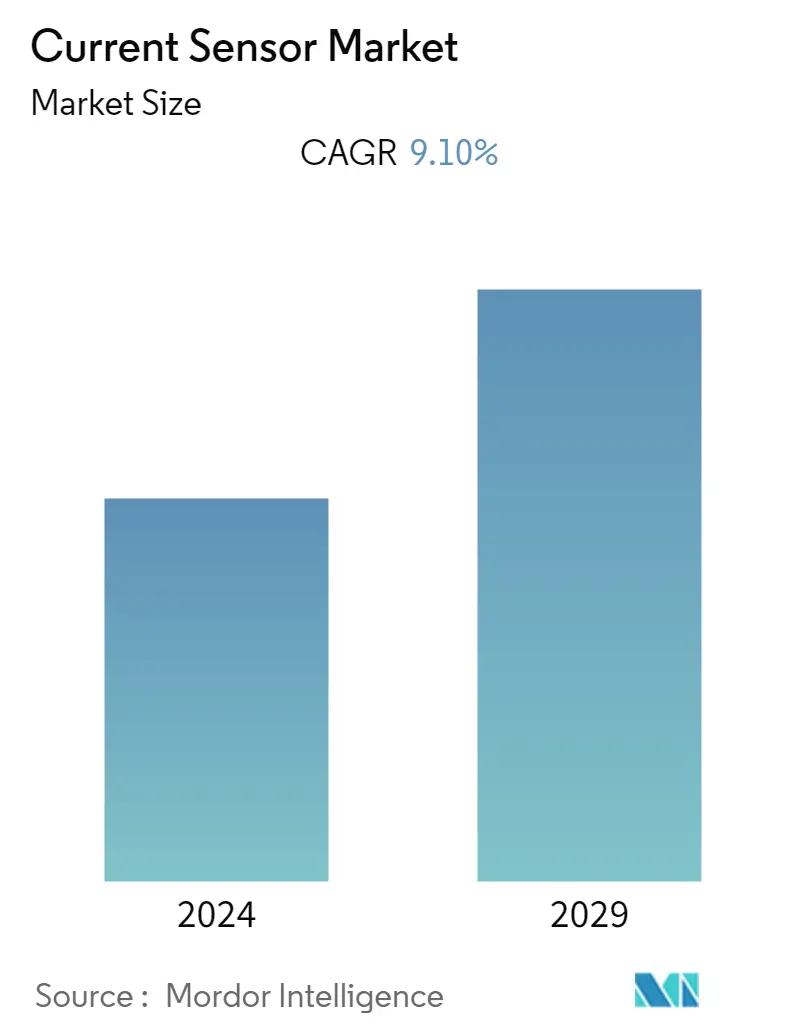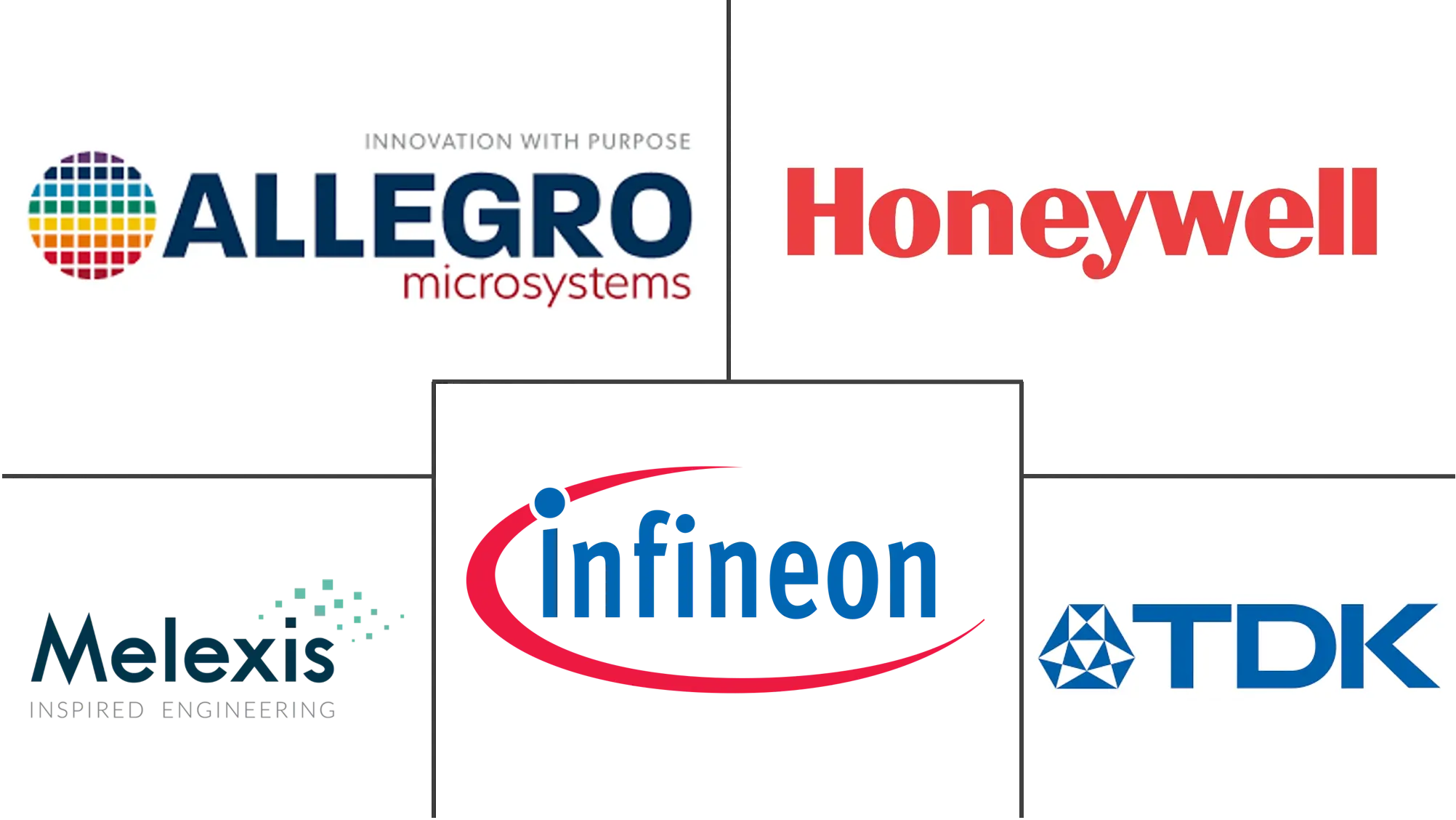Market Size of Current Sensor Industry

| Study Period | 2019 - 2029 |
| Base Year For Estimation | 2023 |
| CAGR | 9.10 % |
| Fastest Growing Market | Asia Pacific |
| Largest Market | North America |
| Market Concentration | Low |
Major Players
*Disclaimer: Major Players sorted in no particular order |
Need a report that reflects how COVID-19 has impacted this market and its growth?
Current Sensor Market Analysis
The current sensor market size is estimated at USD 3,247.50 million in 2023 and is expected to reach USD 5,019.65 million by 2028, registering a CAGR of 9.1 percent during the forecast period (2023-2028). The rapidly increasing use of battery-powered and renewable energy applications drives the market. Smartphones, tablets, and other portable devices need smaller form factors and lower power consumption rates. A highly accurate, ultra-low-power solution for predicting remaining battery life and protecting the circuitry and Li+ battery from overcurrent conditions, the requirement of current sensors is high. Open-loop sensors are typically used in battery-powered applications. They require less power than closed-loop sensors and can better withstand overloads.
- In recent years, the demand for low-cost, accurate, and small-size current sensor solutions has increased across the industrial, automotive, commercial, and communications systems. New design concepts and the systematic utilization of advanced technology have entitled further improvements in IC performance. It has also opened the path to new product approaches by supporting integrating additional functions, such as power protection, in the same current sensor IC.
- For instance, in May 2022, Continental AG launched its high-voltage Current Sensor Module (CSM) and the Battery Impact Detection (BID) system to make EV batteries safe. To support strict functional safety requirements, the CSM is available as a two-channel sensor, measuring current independently by integrating shunt technology and hall technology in a compact, single unit.
- The increasing smartphone penetration is expected to drive the demand for current sensors over the forecast period. For instance, according to Ericsson, smartphone subscriptions are expected to surpass 1.2 billion by 2026. 5G is expected to become a key driving factor, with 26 percent of mobile subscriptions by 2026.
- Further, the Industry 4.0 revolution, in which machines are becoming more intelligent and intuitive, is increasing the need for the industrial applications of sensors. The new devices are designed to be more efficient, safe, and flexible, with the ability to monitor their performance, usage, and failure autonomously. Therefore, these applications spur the demand for current sensors. According to the IFR forecasts, international adoption is anticipated to increase significantly to 518,000 industrial robots operating across plants all around the globe by 2024. The favorable growth trajectory of the industrial robots demand is expected to drive the market for sensors during the same period.
- Furthermore, with the growing concerns about the global demand for energy and the overall augmentation of environmental awareness, designers for power electronics applications are under constant pressure to improve efficiency. The advent of the smart grid, grid-tied photovoltaic (PV), and some other grid-tied renewable energy systems require the growth of high-efficiency power inverters. According to the International Energy Agency's Net Zero Emissions by 2050 Scenario, 300 million electric automobiles will be on the road by 2030, accounting for more than 60 percent of new automobile sales. Because of the widespread usage of current sensors in EVs and HEVs, the automotive end-user is projected to continue to be one of the significator factors for the growth of the current sensor market.
- Large-scale commercialization of IoT and IIoT is bolstering the market. According to Ericsson, the number of cellular IoT links is predicted to reach 3.5 billion in 2023. With the traditional manufacturing sector witnessing a digital transformation, IoT is fueling intelligent connectivity's next industrial revolution. This is transforming the way enterprises approach increasingly complicated systems and machines to enhance efficiency and reduce downtime, creating a good scenario for the growth of the current sensor market.
- However, high cost and technical limitations associated with product development and integration of current sensors integration, along with the rules of current sensors in case of high voltage spikes, high temperature, and current conditions, are some of the major factors challenging the growth of the studied market.
- However, the Russia-Ukraine war is impacting the supply chain of semiconductors, being a major supplier of natural gas and raw materials in producing semiconductors. Additionally, the semiconductor shortage had several impacts on the current sensors market. The shortage of semiconductors could result in delayed production of sensor components, leading to increased costs for current sensor manufacturers, as they may need to pay more increased prices for the limited supply of semiconductors available.
- Moreover, in April 2023, Maruti Suzuki India said that the uncertainties in the electronic component supplies might affect production in FY 24. The shortage of electronic components had some impact on the company's production in FY 2023. Such instances will continue to hamper the growth of the market.
